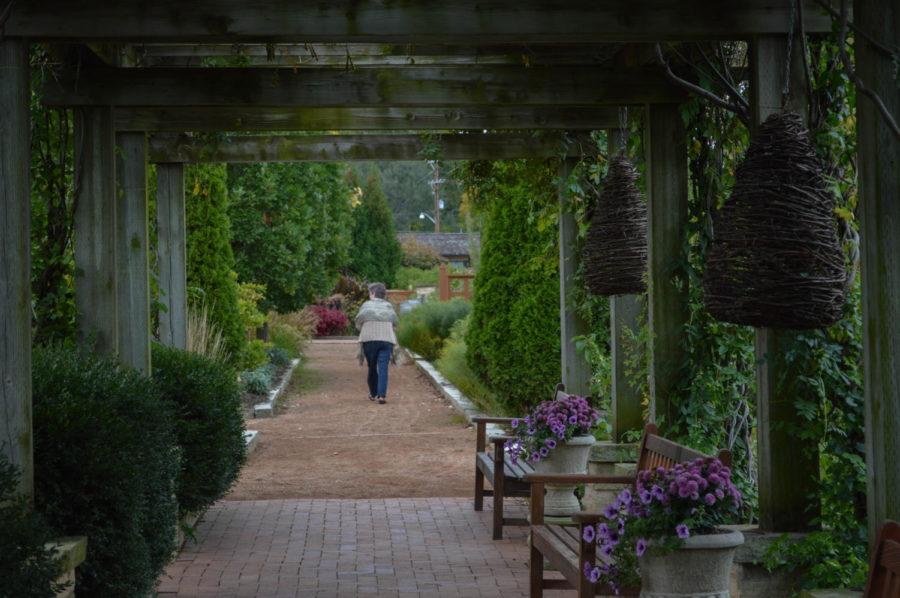Felker: ISU’s Reiman Gardens underappreciated, underutilized
Maddie Leopardo/Iowa State Daily
A woman takes a stroll through Reiman Gardens on free admission day. Reiman Gardens offers free admission to the public every second Wednesday of the month.
March 9, 2017
America’s history of traditionally-manicured public gardens is a short, and mostly uninteresting one. We’ve not got the sort of appreciation and heritage for them that old Europe is so soaked in — no lords or lairds patron to sprawling acres of immaculately-groomed grass lawns, trimmed hedges or shaped trees. Most of our public gardens are actually just urban cemeteries — relics of the early 19th century, when our cities ran out of small churchyards to fill with graves.
But here, right here in Ames, we’ve got a world-class botanical garden within a few minutes’ walk from campus. And I actually wonder how many Iowa State students really even know its scope and beauty — which is to say a full 17 acres (and another 1.25 coming in the near future) of lush verdure, 26 distinct garden areas, an indoor butterfly wing and conservatory, events plaza, herb gardens, rose gardens, courtyards, sculptures and even a small waterbody called Lake Helen complete with koi and floating lilies.
This is to say nothing of the recently planned and approved “Sycamore Falls Project,” which looks to develop the garden’s northern hillside (over the next 20 years) into a tiered garden replete with seven 80-year-old sycamore trees, cascading pools of water and an eventual welcome center and entry courtyard garden.
Inscribed in Reiman Garden’s campanile is a stone that bears the following words courtesy of the garden’s founders Roy and Bobbi Reiman: “Let these gardens be a special place for students to come to quiet their minds, collect their thoughts, and find their futures.”
I wish this were more of a reality than an appeal, but, unfortunately, the gardens are not overly attended by students. I think this is due to a few factors, but none of them are in my mind meaningful enough to discourage our attendance — I am a little disappointed by this. On my visits to the garden, it is rare that I’ve seen any other individual or grouped students. Most visitors are families and local residents.
The real issue, I think, is in the garden’s presentation and isolation. Its main entryway is vista to an ugly corner of the Jack Trice parking lot, and there are no footpaths leading to or from the Garden’s entrance or exit to any place of any worth. To add, it is sandwiched in between a busy segment of University Boulevard and Beach Avenue. How wonderful would it be were there to exist a biking trail that ran from campus to the garden itself? Or even if it simply had a parking lot and entryway of its own — perhaps enclosed by a line of trees and foliage? Would it be too much to give the garden its own space, and some privacy?
I know that I am too picky and too critical, and I am certainly glad that more money is being spent on the garden on anything at all in the first place, but I myself would have addressed these other issues before expanding the grounds themselves. In any case, these are not excuses for the garden’s underappreciation, which is unfortunate. This is one of Iowa State University’s greatest assets and icons, and I wish that it were more of a feature for incoming students and those currently enrolled.
Aside from the garden’s physical beauty itself, the grounds are home to a robust internship program (which makes space for students studying landscape architecture, horticulture, entomology, education, event planning and retail management), a series of “Brown Bag” in-house lectures, themed exhibits and displays and a variety of educational programs that really do substantiate its claim to be a “living classroom.”
So why isn’t the garden utilized more by students? How could we get them there? Here’s my suggestion: take every incoming student to them for a visit. As part of Discover Iowa State, or some other orientation program, march each and every freshman and transfer student through the grounds in groups, and turn it into an experience. Provide lunch. Use the gardens as an attraction, as a destination. Many students, I am sure, do not even know that it exists or what it really amounts to. Show them.
















